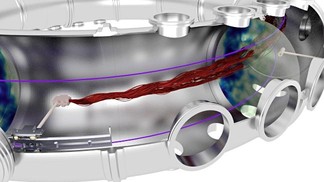Dec 1 2014
CRPP Researchers have demonstrated the influence of the turbulent structures present in the plasma on the diffusion of fast particles injected into the plasma.
 © 2014 EPFL
© 2014 EPFL
In an article published this week in 'Physical Review Letters' (PRL), A. Bovet, Prof. A. Fasoli and Dr MER I. Furno first describe how suprathermal particles, i.e. particles with energy higher than that of plasma particles, disperse radially throughout their journey in the plasma. This phenomenon is generally called ‘particle transport’. They were able to show that this transport is fast (super-diffusion) and intermittent for slightly supra-thermal particle while more energetic particles undergo less rapid transport (sub-diffusion) and more regular.
This result was obtained with a system consisting of a source of suprathermal ions located in the plasma of TORPEX and a detector located about 40 cm away from the source. By moving the detector in the plane perpendicular to the particle beam, it is possible to measure the radial diffusion.
Another detector, also immersed in the plasma, can measure transient turbulent structures called blobs. Jointly analysing data from both systems, the researchers showed that intermittencies were synchronized with these turbulent structures. Furthermore, they demonstrated that the path of fast particles was systematically distorted by the passage of blobs.
To do this, they used conditional-averaging, i.e. calculated the averaged effect, during the time of existence of the blobs, on the position of the fast ion beam.
Finally, they showed that more energetic particles were not influenced by the turbulent structures.
These results thus provide the first answers to a key issue for a fusion reactor: how very fast particles, such as those from fusion reactions, will behave inside the reactor. It would be much more beneficial to a reactor that fast particles do not disperse too quickly so that they provide heating of the plasma itself. These results may also help in understanding the transport of solar particles and observed fluctuations.
Author: Yves Martin
Source: Centre de recherches en physique des plasmas